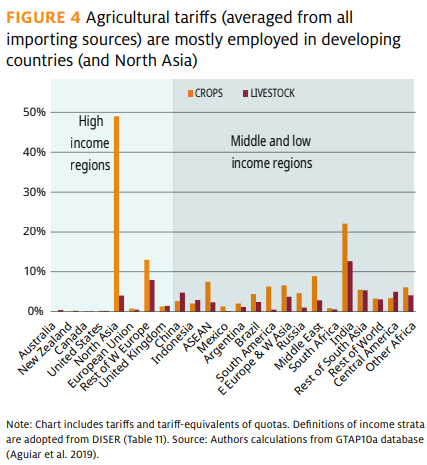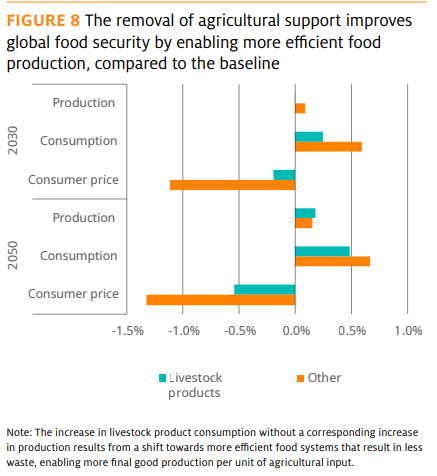
CONSUMER preferences and pressure on governments for cheaper carbon-friendly food could help push heavily subsidised agricultural systems with high greenhouse gas emissions toward lowering subsidies and tariffs.
But capturing the benefits to food insecure economies and the environment will require coordinated action at the multilateral level, according to an ABARES Insights Report.
The report has concluded that improving food security, promoting global growth and cutting emissions can be achieved through the removal of agricultural subsidies and tariffs.
ABARES executive director Dr Jared Greenville said consumers making discerning purchases can encourage low carbon food production and that would shift where it comes from, but the tariff policies of subsidised importing countries would still work against consumers being offered food from lower cost and more efficient GHG-emitting exporting countries.
“It’s just doesn’t happen quickly enough.
“Consumers would help but if they maintained subsidies and tariffs it’s just a longer process to get there.”
Dr Greenville said multilateral action included greater pressure through the World Trade Organisation or the Conference of the Parties (COP) processes. Although he said consumers could also play a role in applying pressure to governments on the issues of food security, subsidies, tariffss and GHG emissions.
“If these global subsidies and tariffs are leading to a global system that is producing more emissions than it needs to, then just like we see in Australia when you get pressure to reduce subsidies to fossil fuels, we are hoping that by establishing the link and the evidence base there, that citizens would also pressure their governments to reduce these (agricultural) subsidies that are akin to those fossil fuels that are leading to higher emissions than there need be.”

Modelling shows reducing ag subsidies can cut GHG emissions
ABARES used the Global Trade and Environment Model (GTEM) to show that reductions in agricultural support would cut global economy-wide emissions if sufficient constraints to agricultural land expansion (such as a ban deforestation) are in place.
“A reduction in agricultural support would also improve food security outcomes, while also cutting unnecessary use of agricultural inputs.
“Economic growth is also boosted across the world, in both high income regions and middle and low income regions, reflecting the removal of distortions and the more efficient flow of resources and investment to activities with greater economic returns,” the report said.
Dr Greenville agreed that the data showed that Australia had a GHG advantage as one of the more efficient less subsidised agricultural producing countries for its exports to the United Kingdom and the EU under trade agreements.
The EU, and especially the UK, through being in a trade agreement with Australia, could help contribute to some of the countries’ other objectives such a contributions to Paris climate targets, he said.
“So instead of it being a negative by reducing barriers on agriculture — and yes there will be some adjustment in their sectors domestically, although we are not going to overrun markets – that they by freeing up trade from the agricultural side from Australia can also point to it as a beneficial achievement against their environmental objectives.”
Dr Greenville said the global community needed to find a way for agriculture to reduce emissions while also feeding the world’s population.
“Agriculture accounts for about 12 per cent of global emissions.
“That’s nearly 6 gigatonnes of CO2-equivalent emissions, including methane, each year,” he said.
“Emissions from agriculture are unavoidable – they’re a fundamental part of the biological processes that go into food production.
“But we know the sector will face increasing pressure to contribute to emissions reductions in order to reach Paris targets,” Dr Greenville said.
“We also know that many governments subsidise and protect agricultural production. Globally, taxpayer support to agriculture has been rising.
At the same time, global emissions from agriculture have been going up,” he said.
“Current levels of global tariffs and subsidies have created significant inefficiencies in the global food system, which is bad news for consumers, global producers and the environment.”
Australia has one of the lowest levels of distorting agricultural subsidies and tariffs across the 38 Organisation for Economic Co-operation and Development (OECD) member countries – and when compared to major emerging economies.
Dr Greenville said this has helped Australian food and fibre to remain competitive in international markets, and underpins our strong and sustainable agricultural sector.
“Globally, there are more efficient ways to farm and produce food, and by eliminating global tariffs on food trade and subsidies to farmers, supported by rules to prevent deforestation, it’s possible to make progress on food security, economic development and emissions reductions,” he said.
“New ABARES modelling shows that through coordinated multilateral action, policymakers can deliver a win-win scenario for the world: cutting global emissions, raising economic growth and improving food security with greater food consumption and lower food prices.”
The emissions, agricultural support and food security report is available here.
Source – ABARES.



HAVE YOUR SAY